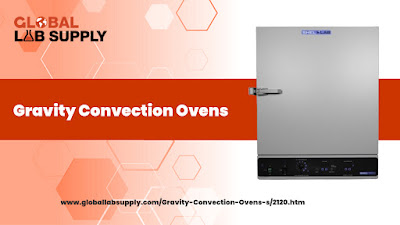In the
realm of laboratory equipment, precision and reliability are paramount.
Researchers, scientists, and technicians around the world rely on specialized
tools to ensure accurate results and reproducible experiments. One such crucial
apparatus is the Gravity Convection Oven, a versatile and essential device that
finds its utility across a wide range of scientific disciplines. In this
article, we will delve into the intricacies of Gravity Convection Ovens,
exploring their applications, advantages, and the significance they hold in the
realm of scientific research and experimentation.
Understanding Gravity Convection Ovens
A Gravity Convection Oven, often referred to as a natural convection oven, is a sophisticated laboratory instrument designed for controlled heating and drying applications. Unlike mechanical convection ovens that use fans to circulate hot air for uniform heat distribution, gravity convection ovens rely solely on the natural movement of air driven by temperature gradients. This design principle ensures a gentle and steady heat transfer process, making it an ideal choice for delicate samples and materials that might be adversely affected by rapid air movement.
Applications across Scientific Disciplines
Gravity Convection Ovens are ubiquitous tools with applications spanning various scientific fields, including chemistry, biology, materials science, pharmaceuticals, and more. Their versatility and precise temperature control make them indispensable for a wide range of tasks:
Sample Drying: Gravity convection ovens excel in drying moisture from samples without causing thermal stress. This makes them valuable in pharmaceutical research for drying granules, powders, and other materials without compromising their integrity.
Annealing and Heat Treatment: Materials science and metallurgy heavily rely on gravity convection ovens for annealing and heat treatment processes. These ovens maintain uniform temperature distribution, crucial for achieving desired material properties.
Bacterial Culturing: In microbiology laboratories, gravity convection ovens provide a controlled environment for bacterial and fungal culturing. The gentle convection prevents airborne contamination while ensuring even growth.
Glassware Sterilization: Laboratories require sterilization of glassware and instruments. Gravity convection ovens offer a reliable method for heat sterilization without the risk of turbulent airflow affecting sensitive components.
Polymer Curing: Polymer research and production often involve curing processes. Gravity convection ovens ensure precise curing of polymers and composites without introducing airflow-induced defects.
Drying of Sensitive Substances: Delicate materials like plant samples, electronics, and artwork benefit from gravity convection ovens, as their gentle heating prevents damage caused by sudden temperature changes.
Advantages of Gravity Convection Ovens
Gravity convection ovens offer a host of advantages that set them apart from other types of laboratory ovens. These benefits contribute to their popularity and widespread usage:
Minimal Air Turbulence: Unlike mechanical convection ovens, gravity convection ovens do not use fans, eliminating turbulent airflow. This feature is critical when working with lightweight, fine, or sensitive samples that could be disturbed by air movement.
Uniform Temperature Distribution: Gravity convection ovens ensure consistent temperature distribution throughout the chamber, minimizing temperature variations that could affect experimental outcomes.
Energy Efficiency: The absence of a fan reduces energy consumption, making gravity convection ovens more energy-efficient and cost-effective in the long run.
Quiet Operation: The lack of a fan results in quieter operation, creating a more conducive working environment and reducing noise pollution in the laboratory.
Less Maintenance: With fewer moving parts, gravity convection ovens generally require less maintenance and have a longer lifespan compared to mechanically driven alternatives.
Compatibility with Sensitive Samples: Gravity convection ovens are well-suited for samples that are susceptible to contamination or damage from airflow, making them an essential tool for maintaining sample integrity.
Factors to Consider When Choosing a Gravity Convection Oven
Selecting the right gravity convection oven for a specific application involves careful consideration of various factors:
Temperature Range and Precision: Different experiments demand specific temperature ranges and precision. Choose an oven that can achieve and maintain the required temperature with minimal fluctuations.
Chamber Size: The internal chamber dimensions should accommodate the size and quantity of samples you intend to work with. A larger chamber allows for more flexibility in experiment design.
Uniformity and Stability: Ensure the oven offers excellent temperature uniformity and stability to guarantee consistent results across all areas of the chamber.
Safety Features: Look for safety features such as over temperature protection, alarms, and automatic shutoff to prevent potential accidents or damage.
Construction and Materials: Ovens constructed with durable, corrosion-resistant materials are essential for longevity and preventing contamination of sensitive samples.
Ease of Use and Programmability: User-friendly controls and programmable settings simplify operation and allow for customized temperature profiles.
Calibration and Validation: Consider whether the oven comes with calibration and validation options to ensure accurate and traceable results.
Global Lab Supply: Elevating Scientific Research with Quality Equipment
In the realm of laboratory equipment and supplies, one name stands out as a trusted provider of high-quality instruments: Global Lab Supply. With a commitment to excellence, Global Lab Supply offers a diverse range of laboratory equipment, including gravity convection ovens that meet the stringent demands of modern scientific research.
Global Lab Supply's gravity convection ovens are designed with precision and attention to detail, ensuring optimal performance and reliability. Their ovens feature advanced temperature control mechanisms, uniform heat distribution, and a range of safety features, making them an invaluable asset for laboratories across various disciplines.
Conclusion
Gravity convection ovens are a cornerstone of modern scientific research, enabling precise and controlled heating and drying of samples across a spectrum of applications. Their unique design, focused on gentle heat transfer and minimal air movement, sets them apart as essential tools for experiments involving delicate, sensitive, or lightweight materials. From pharmaceutical research to materials science and beyond, gravity convection ovens from trusted suppliers like Global Lab Supply play a pivotal role in advancing scientific knowledge and discovery. By understanding their applications, advantages, and factors to consider when selecting one, researchers can make informed choices and ensure the success of their experiments while maintaining the integrity of their samples.

